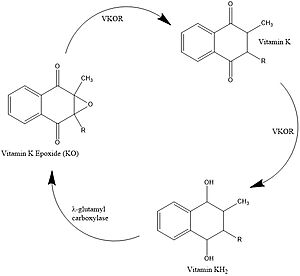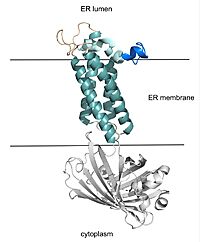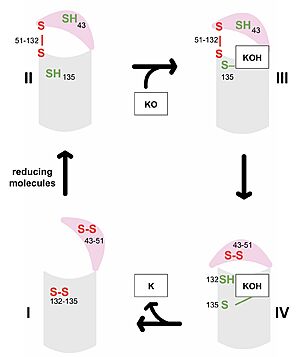Sandbox Reserved 1724
From Proteopedia
(Difference between revisions)
| Line 6: | Line 6: | ||
Vitamin K epoxide reductase (VKOR) is the enzyme responsible for regenerating vitamin K from vitamin K epoxide to support blood coagulation. | Vitamin K epoxide reductase (VKOR) is the enzyme responsible for regenerating vitamin K from vitamin K epoxide to support blood coagulation. | ||
[[Image:Vitamin_K_Cycle_IJEV.jpg|300 px|left|thumb|Figure 1. Vitamin K Cycle]] | [[Image:Vitamin_K_Cycle_IJEV.jpg|300 px|left|thumb|Figure 1. Vitamin K Cycle]] | ||
| - | [[Image:barrel_domain_smaller.jpg|200 px|right|thumb|Figure 2. VKOR with Barrel Domain]] | ||
=== Vitamin K Cycle === | === Vitamin K Cycle === | ||
[https://en.wikipedia.org/wiki/Vitamin_K Vitamin K] is essential for blood clotting in the body. The fully reduced form, KH2, allows the gamma carboxylation of blood clotting cofactors and is turned into the epoxide form in the process. Vitamin K epoxide reductase, abbreviated VKOR, turns the epoxide back to the fully reduced form so the reduced form can be used again. This transformation happens in two steps including converting the epoxide to the partially oxidized Vitamin K quinone then converting the quinone to the fully reduced hydroquinone (KH2). <ref name="Stafford">PMID:16102054</ref> | [https://en.wikipedia.org/wiki/Vitamin_K Vitamin K] is essential for blood clotting in the body. The fully reduced form, KH2, allows the gamma carboxylation of blood clotting cofactors and is turned into the epoxide form in the process. Vitamin K epoxide reductase, abbreviated VKOR, turns the epoxide back to the fully reduced form so the reduced form can be used again. This transformation happens in two steps including converting the epoxide to the partially oxidized Vitamin K quinone then converting the quinone to the fully reduced hydroquinone (KH2). <ref name="Stafford">PMID:16102054</ref> | ||
| + | [[Image:barrel_domain_smaller.jpg|200 px|right|thumb|Figure 2. VKOR with Barrel Domain]] | ||
=== Structural Overview === | === Structural Overview === | ||
VKOR consists of four <scene name='90/904330/Transmembranehelices1/1'>transmembrane helices</scene> embedded in the endoplasmic reticulum membrane. The files on the RCSB Protein Data Bank include a barrel domain that is not pertinent to the function of VKOR. The images presented here have been edited to remove the barrel domain and renumbered to correspond with the article by Liu. <ref name="Liu">PMID:33154105</ref>. The original image with the barrel domain in context is shown in Figure 2. Helices one and two are connected by the <scene name='90/904330/Betahairpin2/1'>beta hairpin</scene> region which contains two of the active cysteines, C43 and C51. VKOR also has a <scene name='90/904330/Capdomain/1'>cap domain</scene> covering the active site, made up of an <scene name='90/904330/Capanchor/1'>anchor</scene>, <scene name='90/904330/Caploop/1'>loop</scene>, and <scene name='90/904330/Caphelix/1'>helix</scene>. | VKOR consists of four <scene name='90/904330/Transmembranehelices1/1'>transmembrane helices</scene> embedded in the endoplasmic reticulum membrane. The files on the RCSB Protein Data Bank include a barrel domain that is not pertinent to the function of VKOR. The images presented here have been edited to remove the barrel domain and renumbered to correspond with the article by Liu. <ref name="Liu">PMID:33154105</ref>. The original image with the barrel domain in context is shown in Figure 2. Helices one and two are connected by the <scene name='90/904330/Betahairpin2/1'>beta hairpin</scene> region which contains two of the active cysteines, C43 and C51. VKOR also has a <scene name='90/904330/Capdomain/1'>cap domain</scene> covering the active site, made up of an <scene name='90/904330/Capanchor/1'>anchor</scene>, <scene name='90/904330/Caploop/1'>loop</scene>, and <scene name='90/904330/Caphelix/1'>helix</scene>. | ||
| + | |||
| + | === Active Site === | ||
| + | VKOR uses two catalytic amino acids, tyrosine 139 and asparagine 80, to stabilize binding to all forms of <scene name='90/904329/Kohhbond/2'>vitamin K</scene> and <scene name='90/904329/Warfarinhbond/3'>vitamin K antagonists</scene>, such as Warfarin, in the binding pocket. Tyr139 and Asn80 hydrogen bond to carbonyl groups on both structures and stabilizes them within the binding pocket <ref name="Liu">PMID:33154105</ref>. | ||
| + | |||
| + | Other than the two previously mentioned hydrogen bonds (Tyr139 and Asn80), <scene name='90/904329/Kohhydrophobic/2'>vitamin K</scene> and <scene name='90/904329/Warfarinhydrophobic/1'> VKOR antagonists</scene> are bound via hydrophobic interactions within the binding pocket of VKOR. Hydrophobic residues of VKOR such as Phe80, Phe87, and Tyr88, form a hydrophobic tunnel within the binding pocket <ref name="Liu">PMID:33154105</ref>. | ||
== Catalytic Cycle == | == Catalytic Cycle == | ||
| Line 18: | Line 23: | ||
The catalytic cycle of VKOR includes transitions from open to closed conformations by means of disulfide bridge-induced conformational changes (Figure 3). Open conformations of VKOR exist when there is no ligand within the binding pocket. Closed conformations exist when some substrate exists within the binding pocket of VKOR. The substituent cysteines (Fig 3, step I) act as reducing agents for the substrate, which can be either Vitamin K epoxide (KO) or partially reduced Vitamin K. | The catalytic cycle of VKOR includes transitions from open to closed conformations by means of disulfide bridge-induced conformational changes (Figure 3). Open conformations of VKOR exist when there is no ligand within the binding pocket. Closed conformations exist when some substrate exists within the binding pocket of VKOR. The substituent cysteines (Fig 3, step I) act as reducing agents for the substrate, which can be either Vitamin K epoxide (KO) or partially reduced Vitamin K. | ||
| - | [[Image:VKOR_Catalytic_cycle.jpg| | + | [[Image:VKOR_Catalytic_cycle.jpg|300 px|right|thumb|'''Figure 3. Catalytic Cycle of VKOR''' VKOR's luminal domain is represented by a the pink semicircle and the transmembrane domain is represented by the gray cylinder. Step I and II represent open conformations of VKOR and steps III and IV represent closed conformations.]] |
The first step of the catalytic cycle (Figure 3) is the wild type open conformation, <scene name='90/904329/Cat_cycle_i/4'>step I</scene>. This step is characterized by an open cap domain with disulfide bonds between cysteines 43 and 51 and between cysteines 132 and 135 <ref name="Liu">PMID:33154105</ref>. The second step of the catalytic cycle is a partially oxidized open conformation, <scene name='90/904329/Cat_cycle_2/5'>step II</scene>. This step is characterized by a disulfide bond between the luminal and transmembrane domain (Fig 3, step II). The transmembrane domain contains a free Cys135 and the luminal domain contains a free Cys43 <ref name="Liu">PMID:33154105</ref>. Step II is labeled as open because no ligand exists within its binding pocket despite the disulfide bridge that connects the luminal and transmembrane domains. The next step of the cycle, <scene name='90/904329/Cat_cycle_3/6'>step III</scene>, is also a closed structure with an intact disulfide bond between Cys51 and Cys132. Cys135 is not involved in a disulfide bridge and assists with substrate binding by forming a stable adduct with KOH or K. This binding induces the closed conformation and uses Cys43 in the luminal membrane for electron transfer <ref name="Liu">PMID:33154105</ref>. <scene name='90/904329/Cat_cycle_4/2'>Step IV</scene> of the catalytic cycle is the last closed conformation. The Cys51-Cys132 bond is broken as Cys43 bonds with Cys51, recreating the disulfide bridge pattern of the open state. Cys132 is then free to bond with Cys135, releasing the product that was bound to the Cys135. Overall the catalytic cycle of VKOR is dependent on open and closed conformational changes of the protein and ultimately is used to generate vitamin K from vitamin K epoxide <ref name="Liu">PMID:33154105</ref>. | The first step of the catalytic cycle (Figure 3) is the wild type open conformation, <scene name='90/904329/Cat_cycle_i/4'>step I</scene>. This step is characterized by an open cap domain with disulfide bonds between cysteines 43 and 51 and between cysteines 132 and 135 <ref name="Liu">PMID:33154105</ref>. The second step of the catalytic cycle is a partially oxidized open conformation, <scene name='90/904329/Cat_cycle_2/5'>step II</scene>. This step is characterized by a disulfide bond between the luminal and transmembrane domain (Fig 3, step II). The transmembrane domain contains a free Cys135 and the luminal domain contains a free Cys43 <ref name="Liu">PMID:33154105</ref>. Step II is labeled as open because no ligand exists within its binding pocket despite the disulfide bridge that connects the luminal and transmembrane domains. The next step of the cycle, <scene name='90/904329/Cat_cycle_3/6'>step III</scene>, is also a closed structure with an intact disulfide bond between Cys51 and Cys132. Cys135 is not involved in a disulfide bridge and assists with substrate binding by forming a stable adduct with KOH or K. This binding induces the closed conformation and uses Cys43 in the luminal membrane for electron transfer <ref name="Liu">PMID:33154105</ref>. <scene name='90/904329/Cat_cycle_4/2'>Step IV</scene> of the catalytic cycle is the last closed conformation. The Cys51-Cys132 bond is broken as Cys43 bonds with Cys51, recreating the disulfide bridge pattern of the open state. Cys132 is then free to bond with Cys135, releasing the product that was bound to the Cys135. Overall the catalytic cycle of VKOR is dependent on open and closed conformational changes of the protein and ultimately is used to generate vitamin K from vitamin K epoxide <ref name="Liu">PMID:33154105</ref>. | ||
| - | |||
| - | ==== Warfarin Dependence on Catalytic Cysteines ==== | ||
| - | The anticoagulant [https://en.wikipedia.org/wiki/Warfarin warfarin] works by inhibiting VKOR (See "Medical Relevance"). Warfarin binding also depends on the catalytic cysteines. Warfarin is able to bind to the fully oxidized open form of VKOR as shown in <scene name='90/904329/Cat_cycle_i/1'>step I</scene>. Once Warfarin binds, VKOR is considered to be in a closed conformation since the substrate cannot enter, despite the lack of disulfide bridge changes. Warfarin can also bind to the partially oxidized form of VKOR as shown in <scene name='90/904329/Cat_cycle_2/1'>step II</scene>. | ||
| - | |||
| - | === Key Substrate Binding Residues === | ||
| - | VKOR uses two catalytic amino acids, tyrosine 139 and asparagine 80, to stabilize binding to all forms of <scene name='90/904329/Kohhbond/2'>vitamin K</scene> and <scene name='90/904329/Warfarinhbond/3'>vitamin K antagonists</scene>, such as Warfarin, in the binding pocket. Tyr139 and Asn80 hydrogen bond to carbonyl groups on both structures and stabilizes them within the binding pocket <ref name="Liu">PMID:33154105</ref>. | ||
| - | |||
| - | === Hydrophobic Interactions === | ||
| - | Other than the two previously mentioned hydrogen bonds (Tyr139 and Asn80), <scene name='90/904329/Kohhydrophobic/2'>vitamin K</scene> and <scene name='90/904329/Warfarinhydrophobic/1'> VKOR antagonists</scene> are bound via hydrophobic interactions within the binding pocket of VKOR. Hydrophobic residues of VKOR such as Phe80, Phe87, and Tyr88, form a hydrophobic tunnel within the binding pocket <ref name="Liu">PMID:33154105</ref>. | ||
== Medical Relevance == | == Medical Relevance == | ||
| Line 36: | Line 32: | ||
Warfarin is a <scene name='90/904330/Bothsubstratevkor/2'>structural mimic</scene> of Vitamin K and acts as a competitive inhibitor. There are around 30 known missense mutations that lead to warfarin resistance in patients, but these mutations do not affect Vitamin K binding for reasons which are not yet fully understood. Such patients require higher doses of warfarin to reach therapeutic level or require a different anticoagulant drug. <ref name="Wu">PMID:29743176</ref> | Warfarin is a <scene name='90/904330/Bothsubstratevkor/2'>structural mimic</scene> of Vitamin K and acts as a competitive inhibitor. There are around 30 known missense mutations that lead to warfarin resistance in patients, but these mutations do not affect Vitamin K binding for reasons which are not yet fully understood. Such patients require higher doses of warfarin to reach therapeutic level or require a different anticoagulant drug. <ref name="Wu">PMID:29743176</ref> | ||
| + | |||
| + | ==== Warfarin Dependence on Catalytic Cysteines ==== | ||
| + | The anticoagulant [https://en.wikipedia.org/wiki/Warfarin warfarin] works by inhibiting VKOR (See "Medical Relevance"). Warfarin binding also depends on the catalytic cysteines. Warfarin is able to bind to the fully oxidized open form of VKOR as shown in <scene name='90/904329/Cat_cycle_i/1'>step I</scene>. Once Warfarin binds, VKOR is considered to be in a closed conformation since the substrate cannot enter, despite the lack of disulfide bridge changes. Warfarin can also bind to the partially oxidized form of VKOR as shown in <scene name='90/904329/Cat_cycle_2/1'>step II</scene>. | ||
===Superwarfarins=== | ===Superwarfarins=== | ||
Revision as of 17:25, 14 April 2022
–
| This Sandbox is Reserved from February 28 through September 1, 2022 for use in the course CH462 Biochemistry II taught by R. Jeremy Johnson at the Butler University, Indianapolis, USA. This reservation includes Sandbox Reserved 1700 through Sandbox Reserved 1729. |
To get started:
More help: Help:Editing |
Vitamin K Epoxide Reductase
| |||||||||||
References
- ↑ Stafford DW. The vitamin K cycle. J Thromb Haemost. 2005 Aug;3(8):1873-8. doi: 10.1111/j.1538-7836.2005.01419.x. PMID:16102054 doi:http://dx.doi.org/10.1111/j.1538-7836.2005.01419.x
- ↑ 2.0 2.1 2.2 2.3 2.4 2.5 2.6 Liu S, Li S, Shen G, Sukumar N, Krezel AM, Li W. Structural basis of antagonizing the vitamin K catalytic cycle for anticoagulation. Science. 2020 Nov 5. pii: science.abc5667. doi: 10.1126/science.abc5667. PMID:33154105 doi:http://dx.doi.org/10.1126/science.abc5667
- ↑ 3.0 3.1 Patel S, Singh R, Preuss CV, Patel N. Warfarin PMID:29261922
- ↑ Wu S, Chen X, Jin DY, Stafford DW, Pedersen LG, Tie JK. Warfarin and vitamin K epoxide reductase: a molecular accounting for observed inhibition. Blood. 2018 Aug 9;132(6):647-657. doi: 10.1182/blood-2018-01-830901. Epub 2018, May 9. PMID:29743176 doi:http://dx.doi.org/10.1182/blood-2018-01-830901
- ↑ Chong YK, Mak TW. Superwarfarin (Long-Acting Anticoagulant Rodenticides) Poisoning: from Pathophysiology to Laboratory-Guided Clinical Management. Clin Biochem Rev. 2019 Nov;40(4):175-185. doi: 10.33176/AACB-19-00029. PMID:31857739 doi:http://dx.doi.org/10.33176/AACB-19-00029
Student Contributors
Izabella Jordan, Emma Varness




